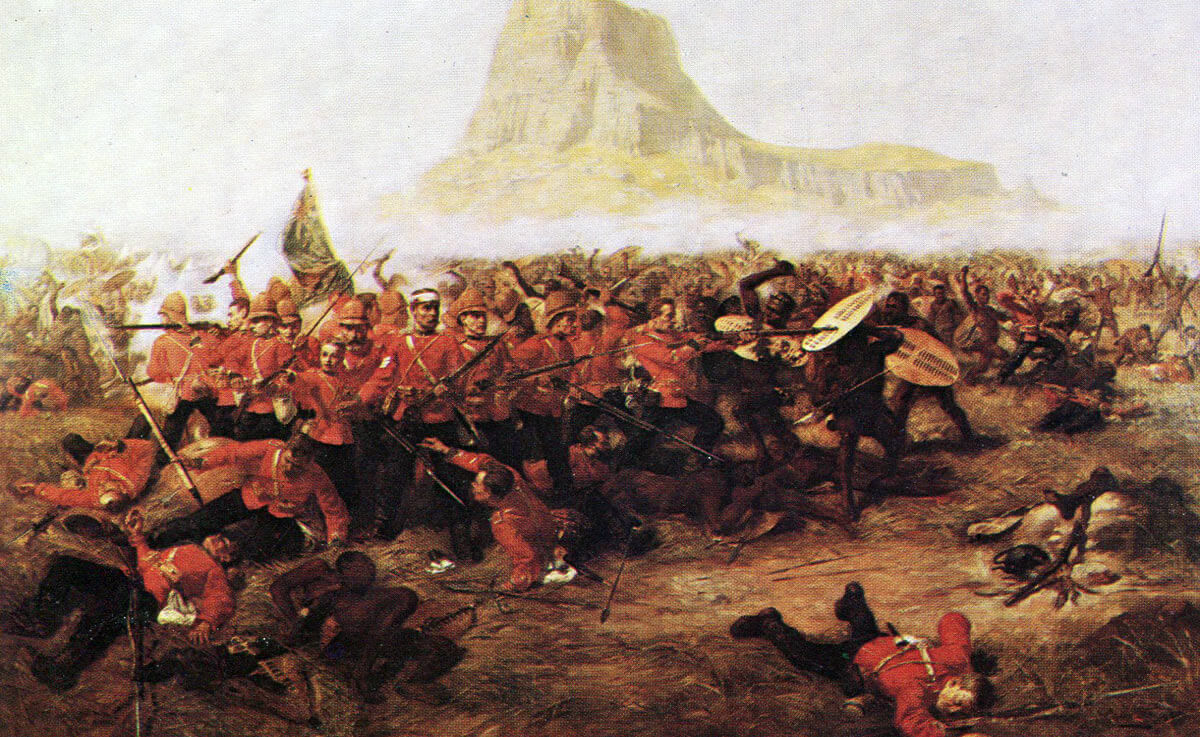

The Zulu Army was commanded by ESA (Princes) Ntshingwayo kaMahole Khoza and Mavumengwana kaNdlela Ntuli. The inDuna Dabulamanzi kaMpande, half brother of Cetshwayo, commanded the Undi Corps after Zibhebhu kaMaphitha, the regular inkhosi, or commander, was wounded.[56]
While Chelmsford was in the field seeking them, the entire Zulu army had outmanoeuvred him, moving behind his force with the intention of attacking the British Army on the 23rd. Pulleine had received reports of large forces of Zulus throughout the morning of the 22nd from 8:00am on. Vedettes had observed Zulus on the hills to the left front, and Lt. Chard, while he was at the camp, observed a large force of several thousand Zulu moving to the British left around the hill of Isandlwana. Pulleine sent word to Chelmsford, which was received by the General between 9:00am and 10:00am.[57] The main Zulu force was discovered at around 11:00am by men of Lt. Charles Raw's troop of scouts, who chased a number of Zulus into a valley, only then seeing most of the 20,000 men of the main enemy force sitting in total quiet. This valley has generally been thought to be the Ngwebeni some 7 miles (11 km) from the British camp but may have been closer in the area of the spurs of Nqutu hill. Having been discovered, the Zulu force leapt to the offensive. Raw's men began a fighting retreat back to the camp and a messenger was sent to warn Pulleine.
Durnford's men, who had been fighting the longest, began to withdraw and their rate of fire diminished. Durnford's withdrawal exposed the right flank of the British regulars, which, with the general threat of the Zulu encirclement, caused Pulleine to order a withdrawal back to the camp. The regulars' retreat was performed with order and discipline and the men of the 24th conducted a fighting withdrawal into the camp. Durnford's retreat, however, exposed the flank of G Company, 2nd/24th, which was overrun relatively quickly.[63]
An officer in advance of Chelmsford's force gave this eyewitness account of the final stage of the battle at about 3:00 pm:
The presence of large numbers of bodies grouped together suggests the resistance was more protracted than originally thought, and a number of desperate last stands were made. Evidence shows that many of the bodies, today marked by cairns, were found in several large groups around the camp – including one stand of around 150 men. A Zulu account describes a group of the 24th forming a square on the neck of Isandlwana.[66] Colonial cavalry, the NMP and the carabiniers, who could easily have fled as they had horses, died around Durnford in his last stand, while nearby their horses were found dead on their picket rope.[67] What is clear is that the slaughter was complete in the area around the camp and back to Natal along the Fugitive's Drift. The fighting had been hand-to-hand combat and no quarter was given to the British regulars. The Zulus had been commanded to ignore the civilians in black coats and this meant that some officers, whose patrol dress was dark blue and black at the time, were spared and escaped.[68]
Nearly the same moment is described in a Zulu warrior's account:
There was no casualty count of the Zulu losses by the British such as made in many of the other battles since they abandoned the field. Nor was there any count by the Zulu. Modern historians have rejected and reduced the older unfounded estimates. Historians Lock and Quantrill estimate the Zulu casualties as "... perhaps between 1,500 and 2,000 dead.[76] Historian Ian Knight stated: "Zulu casualties were almost as heavy. Although it is impossible to say with certainty, at least 1,000 were killed outright in the assault..."[77]
Some 1,000 Martini-Henry rifles, the two field artillery guns, 400,000 rounds of ammunition, three colours, most of the 2,000 draft animals and 130 wagons,[78] provisions such as tinned food, biscuits, beer, overcoats, tents and other supplies, were taken by the Zulu or left abandoned on the field. Of the survivors, most were from the auxiliaries.
